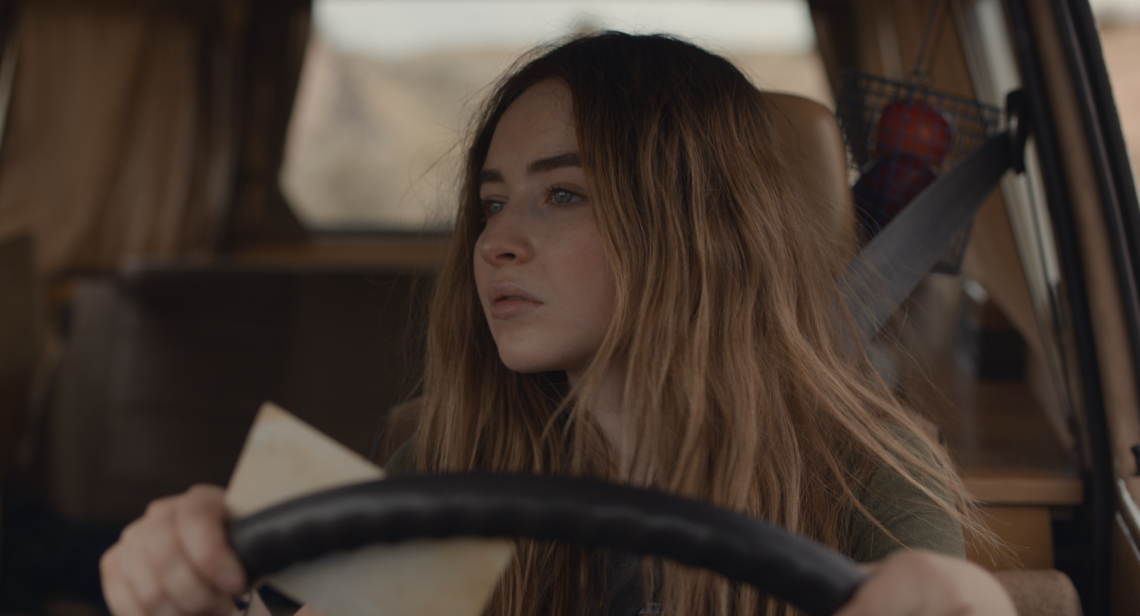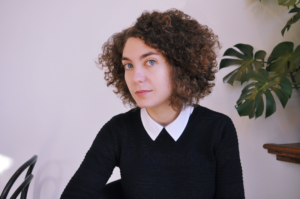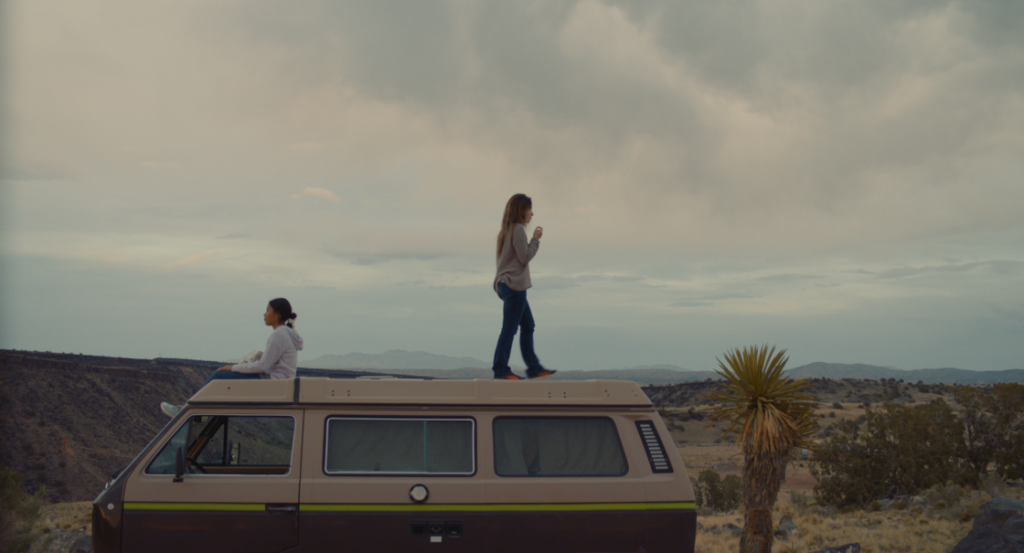
The Short History of the Long Road Interview: Ani Simon-Kennedy
“I’ve always loved road trips, and road trip movies and was hungry for one where a woman struck out on the road, fell in love with that path and lived to tell the tale.”
The sandy stretches and shadowy mountain ranges of New Mexico provide the perfect background to this story of sudden loss, longing for connection and a search for independence.
THE SHORT HISTORY OF THE LONG ROAD follows Nola (Sabrina Carpenter), a young girl who grew up van-dwelling with her father. After an expected event leaves her with few skills, no family and a quickly diminishing wallet, Nola must figure out where she fits in the world.
While the film has typical coming of age themes, it pairs them with the danger of a young girl being out on the open road with no means and no safety net.
Carpenter gives Nola a vulnerable strength as she fights for a way of life she doesn’t know if she wants but is the only one she understands.
With a strong supporting cast, portrayed by Steven Ogg, Danny Trejo, Maggie Siff, Rusty Schwimmer and Jashaun St. John, THE SHORT HISTORY OF THE LONG ROAD is a stunning sophomore feature from writer-director Ani Simon-Kennedy.
To learn more about THE SHORT HISTORY OF THE LONG ROAD and find screenings near you, CLICK HERE.
Tell us a little bit about yourself, and how you got involved with filmmaking.
 Ani Simon-Kennedy: I’m a filmmaker from Paris who now lives in NYC. I started making shorts with my friends in high school. After long summers of babysitting, I bought my first camera. I originally thought I wanted to be a cinematographer, and after graduating from NYU, starting working — first in the art department on studio movies, then as Wes Anderson’s assistant and finally as a camera trainee on Midnight in Paris. I wanted to get out of assisting and finally make my own work.
Ani Simon-Kennedy: I’m a filmmaker from Paris who now lives in NYC. I started making shorts with my friends in high school. After long summers of babysitting, I bought my first camera. I originally thought I wanted to be a cinematographer, and after graduating from NYU, starting working — first in the art department on studio movies, then as Wes Anderson’s assistant and finally as a camera trainee on Midnight in Paris. I wanted to get out of assisting and finally make my own work.
I went to Prague Film School in 2011 where I met cinematographer Cailin Yatsko. I realized by the end that I actually wanted to a writer-director as badly as Cailin wanted to be a DP and when both of our shorts got into the Cannes Short Film Corner, we had to submit a production company name. We came up with Bicephaly Pictures, the scientific term for two-headed. Eight years later, we’ve made two feature films and over 300 shorts together.
Tell us about The Short History of the Long Road, and where the idea for the film came from.
ASK: I first started itching to write a road trip movie even before my first feature film. Days of Gray was a post-apocalyptic Icelandic film with a live score that played during our screenings. As we finished the festival circuit for that difficult-to-categorize project, I started thinking what a more traditional follow-up might look like. I’ve always loved road trips, and road trip movies and was hungry for one where a woman struck out on the road, fell in love with that path and lived to tell the tale (no offence to Thelma & Louise).
Around that time, I discovered van-dwelling and completely immersed myself in that wild subculture of turning your vehicle into your home. I also had always been disappointed with how grief was depicted on screen and wanted to explore a more realistic portrayal of what sudden loss actually feels like. All of those threads came together to inform the writing process of The Short History of the Long Road.
You spoke about the fact that it took years for the film to come together, what was that process like for you and your collaborators?
ASK: I started writing the script in 2015 and things started to gel when it won Best Screenplay at the inaugural Bentonville Film Festival, presented by Geena Davis and Bruce Dern. Cailin and I then were able to use that first crack in the door to submit to other film markets and labs. Institutions like IFP and Film Independent (and then later on Tribeca and Sundance) were hugely supportive. We attached producers and then started the dual process of raising the financing while casting our actors. It was a long process of trying to find money while finding the right cast and not always having both elements time out at the right moment. Finally, everything fell into place and we shot in the spring of 2018 in New Mexico.
The film has some well-known actors attached to it, how did you get them involved?
ASK: I always knew the film would live or die on the shoulders of whoever played our lead, Nola. She’s in every single scene in the movie and her journey carries the entire story. I realized I needed to really build a bond with whoever was going to play her, and holding auditions or sending out offers to agencies wasn’t going to work. I made lists of my favorite young actors and met with anyone who would read the full script and have a conversation about what the story meant to them. I ended up interviewing 30 young women and then had something like a callback session where my favorite six came in to read scenes from the film, some they had chosen and some I had chosen. It wound up feeling like an acting workshop and was a really helpful way for me to gauge their comfort level with improv.
Ultimately, Sabrina Carpenter (Girl Meets World) really had an extraordinary approach to the role and I cast her. Then we were able to cast the wonderful Steven Ogg (The Walking Dead) as her father Clint and the magical Maggie Siff (Billions) as her mother Cheryl. I basically wrote the part of Blue for Jashaun St. John after seeing her in Songs My Brothers Taught Me. Danny Trejo came on board through a friend of a friend of his son Gilbert, who is also a very talented filmmaker. Overall our casting process was very atypical but definitely the right way to go for this film.
A lot of the film takes place on the road, what was it like shooting these scenes?
ASK: It involved some very extensive location scouting! Shooting in and around Albuquerque was incredible — the scenery really makes you want to live out on the open road. The trickiest part was that Sabrina actually wasn’t able to drive at the time! So a combination of process trailer, stunt double and movie magic made it all possible. Much like my first feature Days of Gray which we shot in Iceland, being on location has a huge influence on the stories I like to tell. New Mexico’s palette and landscapes really informed the film.
The Short History of the Long Road is a beautiful portrayal of feeling like an outsider. What about this theme intrigued you?
ASK: Growing up between two countries, the US and France, and feeling at home in both places while never really belonging to either has definitely shaped my outlook on life. I think that growing up, you accept however you are raised as the norm. I thought everyone was bicultural and bilingual when I was younger. It’s only when you yourself become an adult that you realize how many different ways there are to be.
Nola being raised by her father on the road always wonders what it would be like to live differently. But ultimately she chooses her own path — picking and choosing from how she was raised to create her own way of being in the world. Van dwelling is a lifestyle that holds a lot of romance but is also for many people the only way to survive in America today.

Can you tell us about some/all of the other amazing women who worked on this film?
ASK: So many! I have to start with my partner-in-film, Cailin Yatsko who is the rare cinematographer/producer unicorn. This film would actually not exist without the blood, sweat and tears she has poured into the project since day one (and continues to this day!).
Bettina Kadoorie, producer extraordinaire and also a wonderful filmmaker in her own right, was the first person to actually believe in the script when every single financier and company loved the project but ultimately wouldn’t commit. She got us that elusive “first money in” that truly opened the door to making this film more than just a PDF on my laptop.
Morgan Kibby, our genius composer, created a score that took the film to a whole new level. Her ear for the unexpected, her eye for detail and her rock-solid support are some of her best qualities.
Last but certainly not least, Kishori Rajan produced this movie tirelessly, bringing equal parts wisdom and enthusiasm every step of the way. She helped push this boulder up the mountain from the very beginning and is most likely doing some kind of work with our release at this very moment.
Tell us about why you are a feminist and why it’s important to your work.
ASK: Whether I want it to or not, being a woman informs how I am perceived — no matter what I do. Until the world stops treating over half the population like we’re a minority, I’ll be a feminist because there’s no other choice.
What are you working on now/next?
ASK: Most recently, I wrote and directed five short films for the National Council for Behavioral Health. Being a part of Ryan Murphy’s Half Initiative last month was a wonderful way to start dipping my toes into television directing. Otherwise, I’m currently in development on a horror film about mermaids and a mini-series on magic.
Finally, recommend one #MUFFApproved film for our blog readers.
ASK: PORTRAIT OF A LADY ON FIRE.
PORTRAIT OF A LADY ON FIRE.
PORTRAIT OF A LADY ON FIRE.
No movie has moved me so profoundly this year. I’ve loved Celine Sciamma’s work forever and this film is an explosion of her boundless talent. Everything Adele Hanael has stood for, from sharing her story of sexual abuse to walking out at the Césars (the equivalent of the French Oscars) inspires me to no end.
Keep up to date with The Short History of the Long Road: Facebook | Twitter | Instagram. And with Ani: Facebook | Twitter | Instagram
*This post was originally featured on The MUFF Society.*

